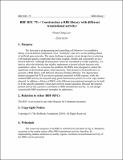Construction a RBS library with different translational activity
Author(s)
Lee, Hsiao-Ching
DownloadBBFRFC79.pdf (814.5Kb)
Terms of use
Metadata
Show full item recordAbstract
The first step in programming and controlling cell behavior is to establish a library of well-defined components, a.k.a. "biobricks", that serve as the building blocks of artificial gene networks. The main challenge in genetic circuit design lies in selecting well-matched genetic components that when coupled, reliably and consistently act in a desired behavior. Although the parameter values are calculated by model equations, it is hard to select the biobricks that reliably implements a desired cellular function with quantitative values. To overcome this problem, the RBSs were designed to control the expression of downstream genes when necessary. This protocol will describe how to generate a RBS library with different ribosome binding affinities. The degenerated primers designed for PCR are used to generate mutations in RBS regions, while the mutated RBS activity are assayed using green fluorescence protein on a low copy number plasmid. In addition, a library of RBS's with different transcriptional strength can be built to fit the specific parameter values derived from model equations. Because the reporter protein activity has a positive correlation to RBS translational activity, we can design customizable RBS translational strengths for application.
Date issued
2010-12-05Series/Report no.
BBF RFC;79
Keywords
RBS
Collections
The following license files are associated with this item: